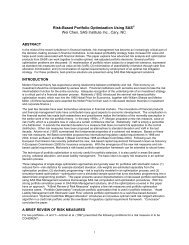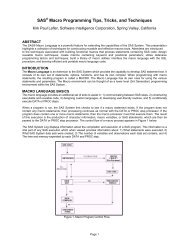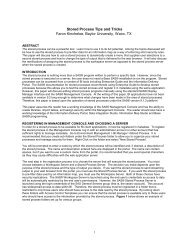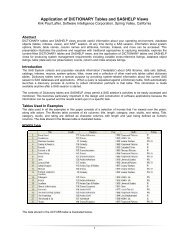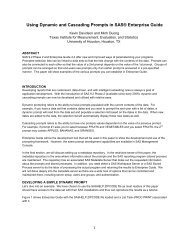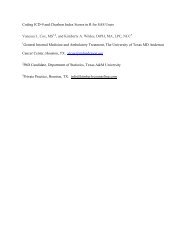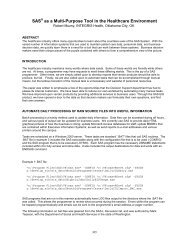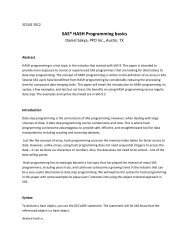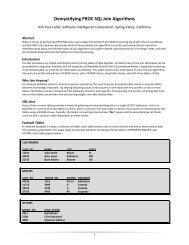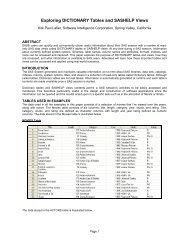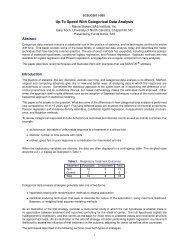construction and usage of arrays of macro variables - South Central ...
construction and usage of arrays of macro variables - South Central ...
construction and usage of arrays of macro variables - South Central ...
You also want an ePaper? Increase the reach of your titles
YUMPU automatically turns print PDFs into web optimized ePapers that Google loves.
ARRAY: <strong>construction</strong> <strong>and</strong> <strong>usage</strong> <strong>of</strong> <strong>arrays</strong> <strong>of</strong> <strong>macro</strong> <strong>variables</strong><br />
Ronald Fehd<br />
Centers for Disease Control, <strong>and</strong> Prevention, Atlanta GA USA<br />
originally published in SUGI-22, revised 2003-June<br />
ABSTRACT<br />
The SAS s<strong>of</strong>tware data step statement array V 3<br />
$ V1-V3 (’A’ ’B’ ’C’); produces three character<br />
<strong>variables</strong> named V1, V2, <strong>and</strong> V3 with<br />
corresponding initial values, ’A’, ’B’, <strong>and</strong> ’C’<br />
<strong>and</strong> a function, dim(V), which returns a value <strong>of</strong><br />
3. Programmers can write simple <strong>macro</strong> tools for<br />
use in larger <strong>macro</strong> procedures. These tools can<br />
duplicate SAS s<strong>of</strong>tware data step <strong>construction</strong>s<br />
that the programmer is comfortable using <strong>and</strong><br />
make reading <strong>and</strong> comprehension easier. The<br />
<strong>macro</strong> statement %ARRAY(V,A B C) produces<br />
three <strong>macro</strong> <strong>variables</strong>, V1, V2, <strong>and</strong> V3, with<br />
corresponding values: A, B, <strong>and</strong> C <strong>and</strong> <strong>macro</strong><br />
variable DIM V with the value 3. These <strong>variables</strong><br />
can then be used in the <strong>macro</strong> iterative loop<br />
statement %DO I = 1 %TO &DIM V.; . This<br />
paper examines the SAS data step array<br />
statement <strong>and</strong> discusses the issues in<br />
constructing <strong>and</strong> using <strong>arrays</strong> <strong>of</strong> <strong>macro</strong>-<strong>variables</strong>.<br />
The <strong>macro</strong> ARRAY takes parameters <strong>of</strong> either a<br />
list <strong>of</strong> elements or a data set.<br />
Macro ARRAY is a basic utility used in two<br />
other <strong>macro</strong>s that address analysis <strong>of</strong> multipleresponse<br />
data. See [3], [4].<br />
INTRODUCTION<br />
A common task for an experienced programmer<br />
is to recognize a recurring pattern <strong>of</strong> code <strong>and</strong><br />
encapsulate that pattern in a routine which<br />
simplifies the processing presentation, while still<br />
enabling later readers <strong>of</strong> the program to grasp the<br />
complex concepts that have been coded.<br />
The SAS s<strong>of</strong>tware <strong>macro</strong> language is a simple<br />
yet powerful programming language. This article<br />
examines the SAS s<strong>of</strong>tware array <strong>and</strong> associated<br />
do loop statements with the idea <strong>of</strong> translating<br />
those concepts into SAS s<strong>of</strong>tware <strong>macro</strong><br />
language <strong>usage</strong>.<br />
SAS array statement <strong>and</strong> dimension (dim)<br />
function<br />
The explicit array statement in SAS s<strong>of</strong>tware has<br />
seven phrases; we will examine the four that are<br />
most commonly used:<br />
1. ARRAY is the SAS statement key-word<br />
2. array-name: required<br />
3. subscript: required, either <strong>of</strong> 3: number<br />
supplied for creation <strong>of</strong> a series <strong>of</strong> <strong>variables</strong> *:<br />
asterisk indicating subscript is determined by<br />
SAS s<strong>of</strong>tware by counting the supplied arrayelements<br />
4. array-elements: an optional list <strong>of</strong> variable<br />
names<br />
The dimension function has two commonly used<br />
phrases:<br />
1. DIM is the SAS function name<br />
2. parameter is an array-name defined in same<br />
data step<br />
A typical <strong>usage</strong> <strong>of</strong> the array statement would<br />
consist <strong>of</strong> accessing one set <strong>of</strong> <strong>variables</strong> in order<br />
to repeat some processing on each variable. The<br />
example in program 1 below reads in three<br />
Fahrenheit temperatures <strong>and</strong> converts them to<br />
Celsius. Note that the proc CONTENTS listing<br />
shows that SAS has created a series <strong>of</strong> <strong>variables</strong><br />
based on the absence <strong>of</strong> the array-elements in the<br />
array Celsius statement. Their names – Celsius1,<br />
Celsius2, <strong>and</strong> Celsius3 - - correspond to the way<br />
the <strong>variables</strong> are accessed in the iterative loop by<br />
the array convention <strong>of</strong> Celsius1, Celsius2, <strong>and</strong><br />
Celsius3.<br />
Program 1<br />
data TEMPRATR;<br />
input Low Med Hi;<br />
array Celsius {3}; *note no arrayelements,<br />
see CONTENTS;<br />
array Farnheit {*} Low Med Hi;<br />
do I = 1 to dim(Farnheit); Celsius{I} =<br />
(Farnheit{I}-32)<br />
* 5/9; end;<br />
cards;*;<br />
proc CONTENTS;<br />
- - - SAS output: - - -<br />
# Variable Type Len Pos<br />
- -------- ---- --- ---<br />
4 CELSIUS1 Num 8 24<br />
5 CELSIUS2 Num 8 32<br />
6 CELSIUS3 Num 8 40<br />
3 HI Num 8 16<br />
1 LOW Num 8 0<br />
2 MED Num 8 8<br />
SAS s<strong>of</strong>tware <strong>macro</strong> language iterative loop<br />
To replicate the SAS s<strong>of</strong>tware iterative loop in<br />
the <strong>macro</strong> language we use a sequentially<br />
102
numbered series <strong>of</strong> <strong>macro</strong> <strong>variables</strong> <strong>and</strong> a <strong>macro</strong><br />
variable containing the dimension:<br />
%LET VAR1 = Q04A;<br />
%LET VAR2 = Q04B;<br />
%LET VAR3 = Q04C;<br />
%LET DIM_VAR = 3;<br />
The <strong>macro</strong> iterative loop <strong>and</strong> <strong>usage</strong> <strong>of</strong> the <strong>macro</strong><br />
<strong>variables</strong> can then be written in a form that is<br />
visually similar to the SAS s<strong>of</strong>tware iterative<br />
loop.<br />
%DO I = 1 %TO &DIM_VAR;<br />
%PUT VAR&I. :: &&VAR&I.; %END;<br />
This loop writes the following note to the SAS<br />
log:<br />
VAR1 :: Q04A<br />
VAR2 :: Q04B<br />
VAR3 :: Q04C<br />
This is a <strong>construction</strong> used regularly in certain<br />
types <strong>of</strong> <strong>macro</strong>s. The purpose <strong>of</strong> this paper is to<br />
construct a <strong>macro</strong> that supports this iterative<br />
loop. Such a <strong>macro</strong> would be named ARRAY,<br />
<strong>and</strong> would have two <strong>of</strong> the SAS array statement<br />
phases as parameters: array-name, <strong>and</strong> arrayelement<br />
values. This <strong>macro</strong> would return a<br />
sequentially- numbered series <strong>of</strong> <strong>macro</strong> <strong>variables</strong><br />
<strong>and</strong> the dimension <strong>of</strong> the array. The arrayelement<br />
values could be either a provided list or<br />
the values <strong>of</strong> a variable in a data set. This second<br />
option <strong>of</strong> providing the array-element values in a<br />
data set would enable <strong>macro</strong> procedures to be<br />
completely data- driven. See [3], [4] for<br />
examples.<br />
A second constraint on the array-name parameter<br />
is that the <strong>macro</strong> variable used for the dimension<br />
has the form: DIM . This<br />
<strong>construction</strong> was chosen to appear visually<br />
similar to the <strong>usage</strong> <strong>of</strong> the dimension function:<br />
dim(). This convention reduces the<br />
length <strong>of</strong> the array-name as prefix to four<br />
characters. The array-name parameter is both<br />
prefix <strong>and</strong> suffix. As suffix to the name <strong>of</strong> the<br />
returned value <strong>of</strong> dimension, it can be no<br />
more than four characters in length. As prefix to<br />
the series <strong>of</strong> <strong>macro</strong> <strong>variables</strong> four characters in<br />
the array-name allows a maximum <strong>of</strong> 9,999<br />
sequentially numbered <strong>macro</strong> <strong>variables</strong> to<br />
be created without suffering a ’SAS name too<br />
long’ error. For larger <strong>arrays</strong>, the length <strong>of</strong> the<br />
array-name can be as small as one character.<br />
Array-elements in the SAS s<strong>of</strong>tware data step<br />
array statement are assumed to be delimited by<br />
spaces. When array-element values are provided<br />
to this routine as a list, the <strong>macro</strong> scan function<br />
is used to pick out each value. The delimiters <strong>of</strong><br />
the <strong>macro</strong> function alpha-numeric characters. For<br />
special cases where, for instance, an arrayelement<br />
value may contain two or more words,<br />
the delimiter parameter may be supplied.<br />
A data set <strong>and</strong> variable name may be supplied as<br />
parameters, instead <strong>of</strong> a list. This routine was<br />
written to h<strong>and</strong>le various series <strong>of</strong> variable<br />
names, which were subsets <strong>of</strong> a proc<br />
CONTENTS output data set. Review the test<br />
data with the <strong>macro</strong>.<br />
Case 1: Scanning <strong>macro</strong> values from a list<br />
Parameters <strong>and</strong> Constraints<br />
The <strong>macro</strong> function scan operates the same as<br />
the SAS s<strong>of</strong>tware function. In order to construct<br />
The simplicity <strong>of</strong> the <strong>macro</strong> language both<br />
a loop which has a data-dependent termination, it<br />
allows <strong>and</strong> requires <strong>construction</strong> <strong>of</strong> a routine that is necessary to use <strong>and</strong> test a temporary variable<br />
has the appearance <strong>of</strong> the SAS s<strong>of</strong>tware array<br />
for the exit condition. Here is pseudo-code for a<br />
statement. Since this is a routine <strong>and</strong> not a SAS loop that converts a list to array-elements:<br />
s<strong>of</strong>tware implementation, there are relations<br />
among the parameters that are constraints. initialize: I := 1<br />
The first <strong>and</strong> most obvious is that the array-name<br />
parameter must follow SAS naming conventions.<br />
SAS names may be up to eight characters in<br />
length. For this routine, some number <strong>of</strong><br />
characters must be reserved for the sequential<br />
numbering <strong>of</strong> the suffix. As the magnitude <strong>of</strong> the<br />
number <strong>of</strong> array-elements increases, the length <strong>of</strong><br />
the array-name must decrease in order for the<br />
combined length to be less than or equal to eight.<br />
loop:<br />
until<br />
pick I-th ITEM from ITEMLIST<br />
assign ITEM to <strong>macro</strong>-variable<br />
increment I<br />
pick I-th ITEM from ITEMLIST<br />
ITEM is blank<br />
Whereas the pseudo-code shows that the test is<br />
done at the bottom <strong>of</strong> the loop, SAS attaches the<br />
until function to the iterative section below, the<br />
<strong>macro</strong> <strong>variables</strong> are global. The index is<br />
incremented using the index is o_ by one; the<br />
dimension is therefore index - 1.<br />
103
Case 2: Symput: <strong>macro</strong> values from a data set<br />
variable<br />
SAS s<strong>of</strong>tware provides the symput function to<br />
transfer values from a data set variable to the<br />
<strong>macro</strong> environment. The symput function takes<br />
two arguments, <strong>macro</strong>-variable name, <strong>and</strong><br />
<strong>macro</strong>-variable value.<br />
symput(mac-var name, mac-var value)<br />
The <strong>macro</strong>-variable name is a character<br />
expression consisting <strong>of</strong> the array-name prefix<br />
plus a suffix which is the series <strong>of</strong> integers from<br />
one to the number <strong>of</strong> observations <strong>of</strong> the data<br />
set. The <strong>macro</strong>-variable value is the value <strong>of</strong> the<br />
data set variable.<br />
symput(prefix + suffix, variable name)<br />
The prefix is a <strong>macro</strong> variable <strong>and</strong> is to be<br />
evaluated as a quoted string. Double exclamation<br />
marks – !! – are used as character-value<br />
concatenation operator. The suffix is an integer<br />
– here, the SAS observation counter – converted<br />
to a character expression.<br />
symput("&ARRAY-NAME." !! left(_N_), varname)<br />
Usage <strong>of</strong> %ARRAY in other <strong>macro</strong>s<br />
The code for creating a <strong>macro</strong> array from a list<br />
was first written as part <strong>of</strong> the %CHECKALL<br />
<strong>macro</strong>. This <strong>macro</strong> analyzes multiple-response<br />
data, a series <strong>of</strong> <strong>variables</strong> which contain answers<br />
to survey questions with the instructions ’check<br />
all that apply’. After typing in hundreds <strong>of</strong><br />
<strong>variables</strong> as lists for the various series, I wrote<br />
the second section which uses a previously<br />
prepared subset <strong>of</strong> a proc CONTENTS data set.<br />
This addition allows both research <strong>and</strong><br />
production <strong>usage</strong> <strong>of</strong> the %CHECKALL <strong>macro</strong>.<br />
See Fehd [3], [4] <strong>and</strong> test data with the <strong>macro</strong>.<br />
DiIorio [1] discusses <strong>macro</strong> <strong>arrays</strong> <strong>of</strong> data set<br />
names.<br />
CONCLUSION<br />
The SAS s<strong>of</strong>tware array <strong>and</strong> do statements are a<br />
simple programming tool which allow a<br />
programmer to access a list <strong>of</strong> <strong>variables</strong>. The<br />
<strong>macro</strong> language allows a programmer to access<br />
a list <strong>of</strong> items with a %DO; statement but lacks a<br />
specific %ARRAY statement. This paper has<br />
presented a <strong>macro</strong> ARRAY which converts<br />
either a list or values <strong>of</strong> a variable into a<br />
sequentially-numbered series <strong>of</strong> <strong>macro</strong>-<strong>variables</strong><br />
with common prefix <strong>and</strong> sequential numeric<br />
suffix <strong>and</strong> also returns a <strong>macro</strong>-variable with the<br />
dimension. This routine hides complexity <strong>and</strong><br />
simplifies readability <strong>of</strong> programs which contain<br />
<strong>macro</strong> loops. The SAS s<strong>of</strong>tware <strong>macro</strong> language<br />
is a simple language. It’s simplicity leaves many<br />
advanced programming concepts apparently<br />
unavailable. It’s simplicity is an asset in that,<br />
with some forethought <strong>and</strong> planning, generic<br />
tools can be relatively easily written. This <strong>macro</strong><br />
was initially developed to take a list <strong>of</strong> variable<br />
names as a parameter. After some <strong>usage</strong> it<br />
became apparent that adding the option to accept<br />
a data set as parameter would eliminate tedious<br />
typing <strong>of</strong> the variable lists, <strong>and</strong>, in addition, since<br />
the routine was then data-driven, guarantee the<br />
accuracy <strong>of</strong> the data thus processed.<br />
REFERENCES<br />
[1] DiIorio, Frank (1996), MACARRAY: a Tool<br />
to Store Dataset Names in a Macro ’Array’,<br />
Proceedings <strong>of</strong> the Fourth Annual Conference <strong>of</strong><br />
the <strong>South</strong>East SAS Users Group, 229-231.<br />
Each <strong>of</strong> the following papers is at:<br />
http://www2.sas.com/proceedings/sugi22/<br />
[2] Fehd, Ronald (1997),%ARRAY: <strong>construction</strong><br />
<strong>and</strong> <strong>usage</strong> <strong>of</strong> <strong>arrays</strong> <strong>of</strong> <strong>macro</strong> <strong>variables</strong>,<br />
Proceedings <strong>of</strong> the Twenty-Second Annual SAS<br />
Users Group International Conference. url suffix:<br />
CODERS/PAPER80.PDF<br />
[3] Fehd, Ronald (1997),%CHECKALL, a<br />
<strong>macro</strong> to produce a frequency <strong>of</strong> response data<br />
set from multipleresponse data Proceedings <strong>of</strong><br />
the Twenty-Second Annual SAS Users Group<br />
International Conference. url suffix:<br />
POSTERS/PAPER236.PDF<br />
[4] Fehd, Ronald (1997),%SHOWCOMB: a<br />
<strong>macro</strong> to produce a data set with frequency <strong>of</strong><br />
combinations <strong>of</strong> responses from multipleresponse<br />
data Proceedings <strong>of</strong> the Twenty-Second<br />
Annual SAS Users Group International<br />
Conference. url suffix:<br />
POSTERS/PAPER204.PDF<br />
SAS is a registered trademark <strong>of</strong> SAS Institute,<br />
Inc. In the USA <strong>and</strong> other countries, indicates<br />
USA registration.<br />
104
Author:<br />
Ronald Fehd bus: 770/488-8102<br />
Centers for Disease Control MS-G23<br />
4770 Buford Hwy NE<br />
Atlanta GA 30341-3724<br />
e-mail: RJF2@cdc.gov<br />
This paper was typeset in LaTeX. For further<br />
information about using LaTeX to write your<br />
SUG paper, consult the SAS-L archives:<br />
http://www.listserv.uga.edu/cgibin/wa?S1=sas-l<br />
Search for :<br />
The subject is or contains : LaTeX<br />
The author’s address : RJF2<br />
Since : 01 June 2003<br />
1 /* MACRO: ARRAY returns a series <strong>of</strong> global <strong>macro</strong>-<strong>variables</strong><br />
2 named &NAME.1 &NAME.2 .. &NAME.n<br />
3 <strong>and</strong> a <strong>macro</strong>-variable named DIM_&NAME.<br />
4 i.e. %ARRAY(VAR,Q04A Q04B Q04C);<br />
5 returns: VAR1::Q04A VAR2::Q04B VAR3::Q04C, DIM_VAR::3<br />
6 PARAMETERS:<br />
7 array-name<br />
8 array-elements: either <strong>of</strong><br />
9 horizontal list <strong>of</strong> array element values<br />
10 delimiters may be specified, see default list<br />
11 vertical list: data set with variable containing array values<br />
12<br />
13 USAGE within <strong>macro</strong>:<br />
14 NOTE: must declare %local mvars DIM_ARRAY-NAME<br />
15 <strong>and</strong> ARRAY-NAME1 ... ARRAY-NAMEn -before- calling ARRAY<br />
16 %ARRAY(ARRAY-NAME,ITEM-LIST); run;<br />
17 %ARRAY(ARRAY-NAME,ITEM-LIST,DELIMITR=/); run;<br />
18 %ARRAY(ARRAY-NAME,DATA=DATA-NAME,VAR=Var-Name); run;<br />
19 USAGE in open code:<br />
20 %ARRAY(ARRAY-NAME,DATA=DATA-NAME,VAR=Var-Name,_GLOBAL_=1);run;<br />
21<br />
22 NOTES:<br />
23 length(ARRAY-NAME) must be
59 * series <strong>of</strong> <strong>macro</strong> <strong>variables</strong>: pg 166<br />
60 * scan : pg 126<br />
61 * symput: pg 165<br />
62 * SAS Macro Language Reference, 1e<br />
63 * ch 5: Scope <strong>of</strong> Macro Variables pg 43--66<br />
64 RJF2:94Jan18 added DELIMITR=default list<br />
65 RJF2:96Feb13 h<strong>and</strong>ling obs=0<br />
66 RJF2:96Jul09 rework scan algorithm for SESUG paper<br />
67 RJF2:96Jul22 simplified error msgs<br />
68 RJF2:96Jul22 removed comma <strong>and</strong> semicolon from DELIMITR<br />
69 RJF2:96Jul24 added PARMBUFF for error msg, polishing<br />
70 RJF2:96Dec27 changed scan to qscan to avoid errmsg scanning NOT<br />
71 RJF2 97Jun17 added _GLOBAL_ to facilitate use in open code<br />
72 RJF2 97Aug11 deleted run at end <strong>of</strong> data _null_ w/call symput<br />
73 to put mac-vars into next higher scope<br />
74 added store <strong>and</strong> des <strong>macro</strong> options<br />
75 RJF2 99Nov30 from SAS-L Ian Whitlock create <strong>macro</strong> array w/SQL<br />
76 RJF2 02Dec04 added ,WHERE=1 in preparation to replace MEMNAMES <strong>usage</strong><br />
77 RJF2 03Jan06 suggest rename ARRAY-NAME to NAME<br />
78 ITEMLIST to ELEMENTS or LIST<br />
79 RJF2 03Jun10 polishing for SESUG/NESUG<br />
80 RJF2 03Jun11 SQL working w/new parms: DIM LIBNAME WHERE<br />
81 *** .................................... ............................ */<br />
82 /*case 1: NAME & LIST ----------------- ---------------------------- */<br />
83 %IF "&NAME." ne ""<br />
84 <strong>and</strong> "&LIST." ne ""<br />
85 <strong>and</strong> %length(&NAME.) le &MAXLENMVARNAME. %THEN %DO;<br />
86 %LET I = 1;<br />
87 %LET ITEM = %Qscan(&LIST.,&I.,&DELIMITR);<br />
88 %DO %until(&ITEM. = );<br />
89 %IF &_GLOBAL_. %THEN %DO; %global &NAME.&I; %END;<br />
90 %LET &NAME.&I = &ITEM.;<br />
91 %LET I = %eval(&I + 1);<br />
92 %LET ITEM =%Qscan(&LIST,&I.,&DELIMITR);<br />
93 %*DO %until; %END;<br />
94 %IF &_GLOBAL_ %THEN %DO; %global DIM_&NAME.; %END;<br />
95 %LET DIM_&NAME. = %eval(&I - 1);<br />
96 %PUT @@ARRAY returns &NAME., dim=&&DIM_&NAME. list=;<br />
97 %* ..................................... . ARRAY-NAME & ITEMLIST*; %END;<br />
98 /*case 2: NAME & (DATA & VAR) --------- ---------------------------- */<br />
99 %ELSE %IF "&NAME." ne "" <strong>and</strong> "&LIST." eq ""<br />
100 <strong>and</strong> "&DATA." ne "." <strong>and</strong> "&VAR" ne "."<br />
101 <strong>and</strong> %length(&NAME.) le &MAXLENMVARNAME. %THEN %DO;<br />
102<br />
103 %IF &_GLOBAL_. %THEN %DO; %GLOBAL DIM_&NAME.;<br />
104 %LET DIM_&NAME. = &DIM.;<br />
105 %DO I = 1 %TO &&DIM_&NAME.; %GLOBAL &NAME.&I.; %END;<br />
106 %*IF _GLOBAL_; %END;<br />
107 proc SQL &PRINT.;<br />
108 select &VAR.<br />
109 into :&NAME.1 - :&NAME.9999<br />
110 from &LIBNAME..&DATA.<br />
111 where &WHERE.<br />
112 ;quit;<br />
113 %LET DIM_&NAME. = &SQLOBS.;<br />
114 /*previous use <strong>of</strong> data step *******************************************<br />
115 proc CONTENTS data = &DATA.<br />
116 (keep = &VAR.) noprint<br />
117 out = CONTENTS<br />
118 (keep = Nobs Type);<br />
119 %IF &_GLOBAL_. %THEN %DO; %global DIM_&NAME.; %END;<br />
120 %ELSE %LET DIM_&NAME. = .;<br />
121 DATA _NULL_;<br />
122 length VarType $ 1;<br />
123 set CONTENTS;<br />
124 if Type = 1 then VarType = ’N’;<br />
125 else VarType = ’C’;<br />
126 call symput("VARTYPE" ,VarType);<br />
127 call symput("DIM_&NAME.",trim(left(put(Nobs,32.)))); stop;<br />
128 run;<br />
129 %IF &_GLOBAL_. %THEN %DO I = 1 %TO &&DIM_&NAME.; %global &NAME.&I.;%END;<br />
106
130 DATA _NULL_;<br />
131 retain I 0;<br />
132 do until(EndoFile);<br />
133 set &DATA end = EndoFile;<br />
134 I + 1;<br />
135 call symput("&NAME." !! left(put(I , 7.0 ))<br />
136 ,trim(left(<br />
137 %IF "&VARTYPE." = "N" %THEN put(&VAR.,best32.16) ;<br />
138 %ELSE &VAR. ;<br />
139 %*symput closure*; )));<br />
140 *do until(EOF)*; end;<br />
141 stop;<br />
142 /*********************************************************************/<br />
143 %PUT @@ARRAY returns &NAME. dim=&&DIM_&NAME. data=&DATA var=&VAR.;<br />
144 %* .................................... ARRAY-NAME & (DATA & VAR); %END;<br />
145<br />
146 %ELSE %DO;%*case 3: print error msg ---- ---------------------------- *;<br />
147 %PUT ERROR: in <strong>macro</strong> ARRAY:;<br />
148 %PUT array-name : required;<br />
149 %PUT array-elements may be list, or (data <strong>and</strong> var);<br />
150 %PUT list : ARRAY(ARRAY-NAME,ITEM-LIST);<br />
151 %PUT data+var: ARRAY(ARRAY-NAME,DATA=DATA-NAME,VAR=VAR-NAME);<br />
152 %IF %length(&NAME.) gt &MAXLENMVARNAME. %THEN<br />
153 %PUT length(ARRAY-NAME) must be



